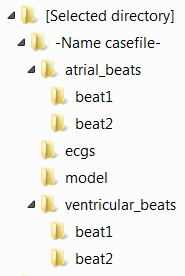
Case Files
Open
The Open menu item starts up a file open dialog to open any of the available files with extension ECGsimcase in the documents folder of the user, e.g. for windows the home folder or any location the user navigated to.
Open default
The Open menu item starts up a file open dialog to open any of the available default ECGsimcase files with extension ECGsimcase in the ECGSIM application directory. These files are read only and should not be saved at its original location.
download case files
On the www.ecgsim.org website more case files for ECGSIM can be found and downloaded. To help you open this website location in a browser, you can open it from within ECGSIM. This is done by pressing the -download case files- menu item. For Windows this item is located in the -Help- main menu item. For OS X it is located in the -application- menu.
Save
The Save menu item saves the case file with extension ECGsimcase. In
case some function values have been changed these changes are saved. When the file is
loaded again these changes are visible again.
It is not possible to save one of the default cases (read only).
Any applied variation in the parameter settings (included in the case file) may be saved
under a unique file name.
Open/Save source info
The Save Source Info menu item saves the source data (parameter values) of all sources within a case file to a seperated file with extension ECGsimsource. When the file is loaded again (Open Source Info) the stored source parameters replace the current ones. If the source file does not match the current case file, no data is loaded.
load ECG file
With the load ECG file menu item a new ECG file can be loaded. This loaded ECG will replace the measured ECG shown in the leads view. To reatore the original measured ECG a reload of the case file is necessary.
Export
This opens a directory dialog, in which all relevant parts of the case file are exported in separate files withing a directory structure.

The following files are saved:
ECG files
The sample frequency is 1000 Hz. Generally the number of measured signals is less than the number of thorax nodes. The remaining signals were interpolated. The following files will be stored in the ecgs subdirectory:
Triangulation files
The triangulation files (Geometry) of:
will be stored in the model subdirectory.
- atria and ventricles,
- thorax,
- left and right lung.
- left and right blood cavaty.
Source parameters
The values of the user adapted source parameters for the atria (if available) and ventricles (if available):
will be stored in a, per beat subdirectory (beat[1-x]) within the ventricular_beats or atrial_beats subdirectory.TMP waveforms
The TMP waveforms at every node on the atria (if available) and ventricles (if available):
will be stored in a, per beat subdirectory (beat[1-x]) within the ventricular_beats or atrial_beats subdirectory.
- the TMP computed with user adapted parameter settings, .user.source (Matrix).
Lead loactions
The electrode locations for all lead systems. For example, for the 12 leads system, the electrode positions are stored in the order of VR, VL, VF, V1-V6. The following files will be stored in the ecgs subdirectory:
- electrode positions for each lead system (.elec asci),
File Formats
Matrix
The format of matrix files is:
L (long), T (long) => p(1, 1), p(1, 2), ..., p(1, T) p(2, 1), p(2, 2), ..., p(2, T) ... ... ... ... ... ... ... ... p(L, 1), p(L, 2), ..., p(L, T)
where L is the number of rows that follow, T is the number of columns and p(l,t ) is the data (float type)
Asci files
The format of asci (text) files is:
L, 1 => p(1, 1) p(2, 1) ... ... p(L, 1)
where L is the number of rows that follow and p(l, 1) is the data
Geometry files
The format of the files that describe triangulated geometries is as follows:
npnt => 1 x(1), y(1), z(1) 2 x(2), y(2), z(2) ... ... ... ... ... ... ... ... npnt x(npnt), y(npnt), z(npnt)
ntri => 1 ind(1, 1), ind(1, 2), ind(1, 3) 2 ind(2, 1), ind(2, 2), ind(2, 3) ... ... ... ... ... ... ... ... ntri ind(ntri, 1), ind(ntri, 2), ind(ntri, 3)
where npnt is the number of nodes, x(i), y(i) and z(i) are the coordinates (in meters) of node i, ntri is the number of triangles, and ind(j,1), ind(j,2) and ind(j,3) are the indices of the nodes of triangle j. The order of the indices for a triangle defines the orientation of the triangle; when viewed from the outside the nodes are numbered clockwise.
